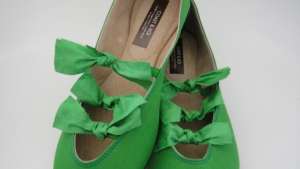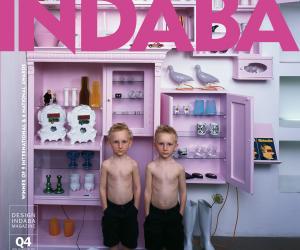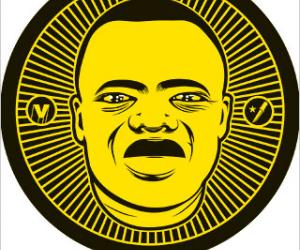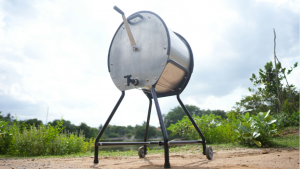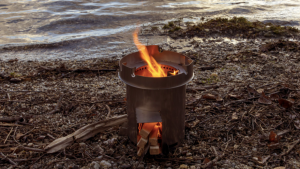From the Series
First Published in
Spanish shoe designer Laura Villasenin has incorporated Peet Pienaar’s graphic finesse and quirky slogans in her new range of shoes and bags.
Having long wanted to make a range of eco-friendly, fair-trade shoes that did not conform to the ethnic or hippy cliché, Villasenin was inspired by Pienaar’s work, which she came across while on holiday in South Africa. After communicating over e-mail, they agreed that Pienaar would do the graphic details and packaging for Villasenin’s shoes, in return for which, Villasenin would assist Pienaar in designing sneakers.
Based on her ecological ideals, Villasenin decided to explore the South African manufacturing alternatives too. “The idea was to source materials from within southern African countries and use vegetable tan leathers to make it as eco-friendly as possible,” she explained. For the handbags, however, she used the much-lauded Ugandan bark cloth. The multifunctional aspects of her designs – knee-high boots zipping down into anklets and large handbags folding into purses – also adhere to green design principles.
“This is a high-end product rather than being mass-produced because you can’t compete with China on that anyway. In Spain and Italy, they’ve already positioned themselves in terms of high quality,” said Villasenin who previously worked at ethical footwear label Terra Plana in London. After completing the project with Pienaar, she returned to Spain to take up a position with Camper.
Pienaar was thrilled to try a hand at footwear design. His limited-edition leather sneakers sport a unique lace-up structure with gold alphabet beads. He also has an experimental distribution plan, which entails an inflatable shop that will travel around the country.
“It’s so exciting to think that one can actually design sneakers because one tends to think that they only do it in China. But unless you’ve studied shoe design, there’s a big gap because you can’t communicate with the factory. Even if you know what you want, unless you have the terminology it’s impossible to get there with the factory,” said Pienaar.
Spanish shoe designer Laura Villasenin has incorporated Peet Pienaar’s graphic finesse and quirky slogans in her new range of shoes and bags.
Having long wanted to make a range of eco-friendly, fair-trade shoes that did not conform to the ethnic or hippy cliché, Villasenin was inspired by Pienaar’s work, which she came across while on holiday in South Africa. After communicating over e-mail, they agreed that Pienaar would do the graphic details and packaging for Villasenin’s shoes, in return for which, Villasenin would assist Pienaar in designing sneakers.
Based on her ecological ideals, Villasenin decided to explore the South African manufacturing alternatives too. “The idea was to source materials from within southern African countries and use vegetable tan leathers to make it as eco-friendly as possible,” she explained. For the handbags, however, she used the much-lauded Ugandan bark cloth. The multifunctional aspects of her designs – knee-high boots zipping down into anklets and large handbags folding into purses – also adhere to green design principles.
“This is a high-end product rather than being mass-produced because you can’t compete with China on that anyway. In Spain and Italy, they’ve already positioned themselves in terms of high quality,” said Villasenin who previously worked at ethical footwear label Terra Plana in London. After completing the project with Pienaar, she returned to Spain to take up a position with Camper.
Pienaar was thrilled to try a hand at footwear design. His limited-edition leather sneakers sport a unique lace-up structure with gold alphabet beads. He also has an experimental distribution plan, which entails an inflatable shop that will travel around the country.
“It’s so exciting to think that one can actually design sneakers because one tends to think that they only do it in China. But unless you’ve studied shoe design, there’s a big gap because you can’t communicate with the factory. Even if you know what you want, unless you have the terminology it’s impossible to get there with the factory,” said Pienaar.
Product developer Amanda Youngleson uses design to “overcome the whole development context of bad tools, poor skills, limited markets and deep poverty”. Her recent project in Ilha da Mozambique saw her applying 10 years of experience under genuinely trying circumstances.
Ilha da Mozambique is a Northern island joined to the mainland by a 3km bridge. Originally the Portuguese capital of Mozambique, in the 1960s after independence, it was ruled that no Portuguese could have second houses and the old town was nationalised. Since then, the island has fallen into decay with many of the houses literally taken over by wild fig trees.
“Anyone who goes there will fall in love with it because it’s this romantic time capsule of history, but at the same time a melancholic experience because it’s falling down,” explains Youngleson.
According to Youngleson, the 16 000 inhabitants subsist off the sea and there is little to no economy of any sort. In response to the environmental threat that this unsustainable community poses to the coastal resources, Mozambique development agency Cedarte commissioned Youngleson to initiate a community project that could generate an alternative source of income.
“For a lot of impoverished people craft is a way of getting into the economy. You don’t need to have too much and you can buy and sell in quite an unsophisticated way. In fact, a Cape Craft and Development Institute survey shows that it is a billion-rand industry but it is not very visible. Nonetheless, it makes a massive difference to household income, even if it just brings in R700 a month,” says Youngleson, who used to run the product development clinic at the CCDI.
Despite the limitations presented by pitiable sewing skills, an unreliable charcoal iron, foot-pedalled sewing machines, rusty pins and scissors so blunt that a brick had to be used to cut the material, Youngleson developed a fashion range made from the local kapulana fabric. Catering for the limitations, the garments were designed to be unisex, one-size-fits-all, wrap-around garments without zips or buttons. A patchwork bag was also designed to ensure that no material was wasted.
The collection was presented at a fashion fair in Maputo where it was enthusiastically received. Trained to maintain the project without Youngleson’s supervision, the crafters are expected to establish a unique tourist attraction and market.
More info: toamanda@iafrica.com





